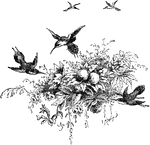
The Ear Bone of Fowl
"Mature stapes of fowl, about x4; after Parker. st, its foot, fitting fenestra ovalis; mst, main shaft,…

Common Fowl Skull
"Schizognathous skull of common fowl, nat. size, from nature, by Dr. R.W. Shufeldt, U.S.A. Letters as…
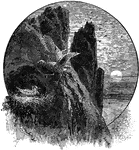
Fulmar and Nest
"Fulmarus. Fulmar. Adult: White; mantle pale pearly-blue, restricted to back and wings, or extending…

Slender-billed Fulmar
"Priocella tenuirostris. Slender-billed Fulmar. Adult: Plumage white, with clear pearly-blue mantle,…
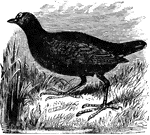
Gallinule
"Gallinula. Gallinules. Water Hens. Mud Hens. Bill not longer than head, stout at base, tapering, compressed,…

The Glottis of a Rook
"Glottis, or opening of trachea in the mouth; a, base of tongue; b, b, horns of hyoid bone; c, rima…

Black-capped Gnat-catcher
"- a, head of a (Polioptila nigriceps) Black-capped Gnat-catcher. b, head of a(Polioptila caerulea)…
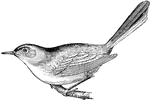
Blue-gray Gnat-catcher
"Grayish-blue, bluer on the crown, hoary on the rump, the forehead black, continuous with a black superciliary…
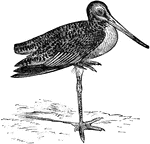
Marbled Godwit
"Limosa fedoa. Great Marbled Godwit. Marlin. Feathers not extending on side of lower mandible to a point…
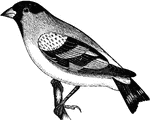
Lawrence's Goldfinch
"Astragalinus lawrencii. Lawrence's Goldfinch. Gray, more or less tinged with yellowish, whitening on…

American Goldfinch
"Astragalinus tristis. American Goldfinch. Yellow-bird. Thistle-bird. In summer: Rich yellow, changing…

Arkansaw Goldfinch
"Astragalinus psaltria. Arkansaw Goldfinch. Upper parts uniform olive-green, without any black; below…
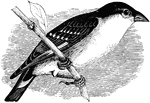
Mexican Goldfinch
"Astragalinus mexicanus. Mexican Goldfinch. The upper parts continuously-black, and the black of the…
Goose Hyoid
"Fig 72 - Hyoid bones of a goose, nat. size; Dr. R.W. Shufeldt, U.S.A. a, cartilaginous end-piece of…
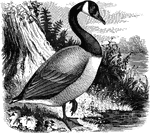
Canada Goose
"Bernicla canadensis. Canada Goose. Common Wild Goose. Tail normally 18-feathered. Bill, feet, head,…
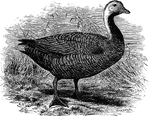
Emperor Goose
"Philacte canagica. Painted Goose. Emperor Goose. Wavy bluish-gray, with lavender or lilac tinting,…
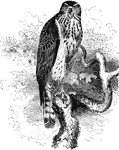
American Goshawk
"Astur atricapillus. American Goshawk. Blue Hen Hawk (adult). Chicken Hawk (young). Adult: Above, dark…

Purple Grackle
"Quiscalus purpureus. Purple Crow Blackbird. Common Crow Blackbird. Purple Grackle. Of medium size,…
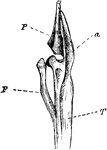
Leg Bones of a Grebe
"F. Fibula; T, tibia, with a, its cnemial process, and P, large patella, of a grebe." Elliot Coues,…

Black Throated Green Warbler
"Black Throated Green Warbler or Dendroica virens. Back and crown clear yellow-olive; forehead, superciliary…

Black-headed Song Grosbeak
"Zamelodia melanocephala. Black-headed Song Grosbeak. Adult male with the crown, sides of head, back,…
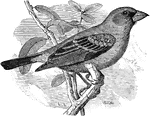
Blue Grosbeak
"Guiraca caerulea. Blue Grosbeak. Adult male: Rich dark blue, nearly uniform, but darker or blackish…

Cardinal Grosbeak
"Cardinalis virginianus. Cardinal Grosbeak. Cardinal Red-bird. Virginia Nightinggale. male, adult: Rich…

Evening Grosbeak
"Hesperophona vespertina. Evening Grosbeak. General color sordid yellow, overlaid with sooty-olive shade,…
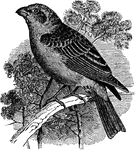
Pine Grosbeak
"Pinicola enucleator. Pine Grosbeak. Light carmine or rosy-red, feathers of back with dusky centres;…
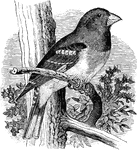
Rose-breasted Song Grosbeak
"Zamelodia ludoviciana. Rose-breasted Song Grosbeak. Adult male with the head and neck all around and…
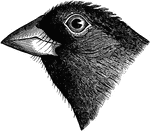
Blue Grosbeak Bill
"Guiraca. Blue Grosbeak. Bill Commissure strongly angulated far beyond base, with deep under mandible…
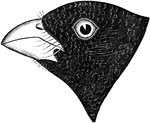
Song Grosbeak Bill
"Zamelodia. Song Grosbeak. Bill extremely heavy, with the lower mandible as deep as the upper or deeper,…

Ruffed Grouse Head
"Bonasa umbella. Ruffed Grouse. "Partridge;" "Pheasant;" Above, variegate reddish- or grayish-brown,…

Canada Grouse
"Canace canadensis. Canada Grouse. Spotted Grouse. Spruce Grouse. Spruce "Partridge." Adult: Head smooth,…

Ruffed Grouse
"Bonasa umbella. Ruffed Grouse. "Partridge;" "Pheasant;" Above, variegate reddish- or grayish-brown,…

Sharp-tailed Grouse
"Pediaecetes phasianellus Columbianus. Common Sharp-tailed Grouse. Upper parts closely and pretty evenly…

Common Guillemot
"Lomvia troile. Common Guillemot, or Murre. Adult in summer: Head and neck all around rich dark maroon…

Black Guillemot Bill
"Uria grylle. Black Guillemots. Bill much shorter than head, about equal to tarsus, straight, rather…

Bustard Gular Pouch
"Gular pouch of bustard; a, tongue; b, the pouch, opening under a, hanging in front of c, the trachea,…

Laughing Gull Bill
"Chroicocephalus atricilla. Laughing Gull. Black-headed Gull. Bill longer than middle toe and claw,…

White-headed Gull Head
"Larus heermanni. White-headed Gull. Bill shorter than head or tarsus, rather slender, moderately compressed,…

Harrier Ear Parts
"Circinae. Harriers. Face surrounded with an incomplete ruff (as in most owls); orifice of ear about…
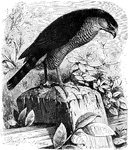
Sharp-shinned Hawk
"Accipiter fuscus. Sharp-shinned Hawk. "Pigeon" Hawk. Above, dark plumbeous, slate-color, or bluish-gray,…
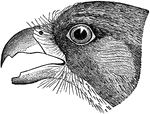
Sparrow Hawk
"Falco sparverius. Rusty-crowned Falcon. Sparrow Hawk. Adults: Crown ashy-blue, with a chestnut patch,…
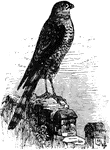
Sharp-shinned Hawk - Small
"Accipiter fuscus. Sharp-shinned Hawk. "Pigeon" Hawk. Above, dark plumbeous, slate-color, or bluish-gray,…
The Foot of a Prairie Hen
"Cupidonia. Tarsi scant-feathered to the toes in front and on sides, bare on a strip behind; toes extensively…
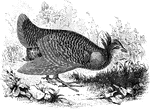
Prairie Hen
"Cupidonia cupido. Pinnated Grouse. Prairie Hen. Above, variegated with black, brown, tawny, or ochrey,…
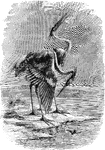
Heron
"Ardea. Great Herons. Of largest size, former well feathered all around. Tibia extensively denuded below.…
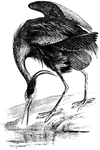
Great Blue Heron
"Ardea herodias. Great Blue Heron. Of large size, and varied dark colors, not dichromatic. Back without…
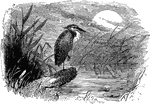
Night Heron
"Nyctiardea grisea naevia. Black-crowned Night Heron. Qua-bird. Squawk. Crown, scapulars and interscapulars…
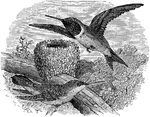
Ruby-throated Humming-bird
"Trochilus colubris. Ruby-throated Humming-bird. Tail forked, its feathers all narrow and pointed; no…

The Hyoid-bone of a Rook
"Hyoid bone; a, glosso-hyal, tipped with cartilage, its posterior horn being certo-hyals proper; b,…
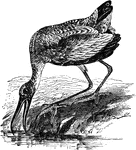
Wood Ibis
"Tantalops loculator. American Wood Stork. Wood Ibis. Colorado Turkey. Plumage white, the wing-quills,…
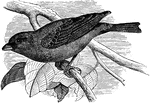
Indigo-bird
"Passerina cyanea. Indigo Painted Finch. Indigo-bird. Adult male: Indigo-blue, intense and constant…
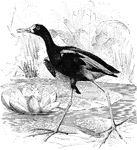
Parra Jacana
"Parra. Jacanas. Bill plover-like, contracted in continuity, enlarged terminally; with culmen depressed…
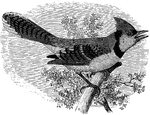
Blue Jay
"Cyanocitta cristata. Blue Jay. Male: Purplish-blue, below pale purplish-gray, whitening on throat,…

Canada Jay
"Perisoreus canadensis. Canada Jay. Whiskey Jack. Moose-bird. Gray whitening on head, neck, and breast;…

Long-crested Jay
"Cyanocitta stelleri macrolopha. Long-crested Jay. Upper parts sooty umber-brown, with a faint blue…
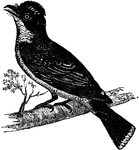
King-bird
Tyrannus carolinensis. King-bird. Bee-martin. No olive nor decided yellow. Only outer primaries obviously…
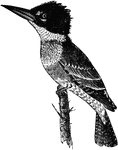
Belted Kingfisher
"Ceryle alcyon. Belted Kingfisher. Upper parts, broad pectoral bar, and sides under the wings, dull…
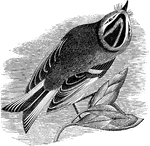
Golden Crested Kinglet
"Upper parts olive-green, more or less bright, sometimes rather olive-ashy, always brightest on the…
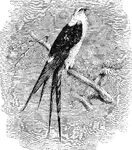
Swallow-tailed Kite
"Elanoides forficatus. Swallow-tailed Kite. Adult: Head, neck, band on rump, and entire under parts,…
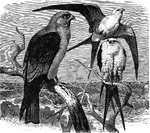
Two Swallow-tail and One Mississippi Kites
Two Swallow-tail and One Mississippi Kite. "Ictinia subcaerulea. Mississippi Kite. General plumage plumbeous…
